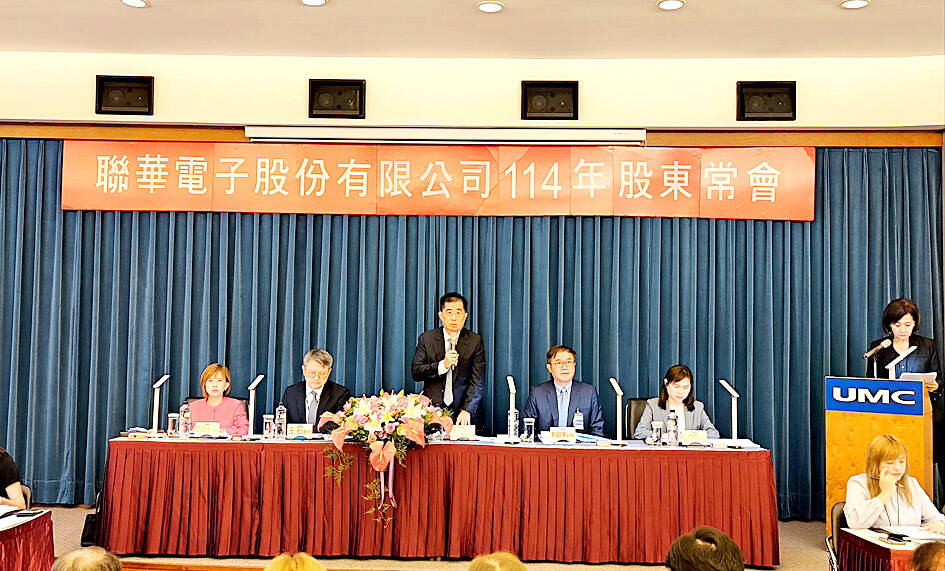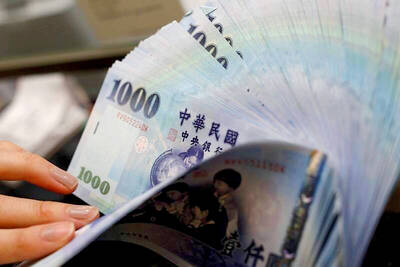United Microelectronics Corp (UMC, 聯電), the world’s third-largest wafer foundry service provider, yesterday said that the appreciation of the New Taiwan dollar, which has surged at its fastest pace in four decades against the US dollar, poses a significant threat to its revenue and profitability in the second half of this year.
As order visibly remains vague for the second half of the year, foreign exchange rate volatility is a more real and visible factor that would affect the chipmaker’s financial performance than capricious tariff policies, UMC chief financial officer Liu Chi-tung (劉啟東) told reporters on the sidelines of its annual shareholders’ meeting in Hsinchu.
“We are more worried about the impact of foreign exchange rates in the second half of the year,” Liu said.

Photo courtesy of United Microelectronics Corp
The NT dollar has hovered at about NT$29 to NT$30 against the greenback recently, having strengthened 8.9 percent since the beginning of this year.
Against this backdrop, the chipmaker has to absorb the impact of the currency’s appreciation, as its revenue is in US dollars, it said.
For every 1 percent the NT dollar gains against the US dollar, UMC’s gross margin would reduce by 0.4 percentage points, Liu said.
“The negative impact will be direct and evident on our second-half [results],” he said.
UMC sees its revenue growth driver this year from customers’ increasing adoption of 22-nanometer technology — the most advanced technology available from the firm — from 28-nanometer technology, Liu said.
The technology is critical for UMC to gain an upper hand against Chinese competitors, which are expanding the capacity of mature technologies at lower cost, he said.
Furthermore, UMC is offering specialized and customized services to customers to differentiate itself from its competitors, he added.
Asked about the company’s overseas expansion strategy, Liu said UMC is prioritizing developing 12-nanometer technology jointly with Intel Corp, with greater interest from several customers, Liu said.
Volume production is arranged for 2027 at Intel’s fab in the US, he said.
That provides an extra manufacturing site selection for customers amid escalating geopolitical tensions, Liu said.
The 12-nanometer project has enormous market potential and is cost-efficient, as no extreme ultraviolet lithography machines would be required in the manufacturing process, he said.
UMC has also received interest from Middle Eastern companies to build new chip manufacturing facilities based on mature technologies in the region, Liu said.
Capacity expansion would not be UMC’s priority, Liu said, adding that the firm would only invest on the grounds of customer base enlargement or market share expansion.
Shareholders yesterday approved the company’s proposal to distribute a cash dividend of NT$2.85 per share, a payout ratio of 75 percent based on last year’s earnings per share of NT$3.8.

Merida Industry Co (美利達) has seen signs of recovery in the US and European markets this year, as customers are gradually depleting their inventories, the bicycle maker told shareholders yesterday. Given robust growth in new orders at its Taiwanese factory, coupled with its subsidiaries’ improving performance, Merida said it remains confident about the bicycle market’s prospects and expects steady growth in its core business this year. CAUTION ON CHINA However, the company must handle the Chinese market with great caution, as sales of road bikes there have declined significantly, affecting its revenue and profitability, Merida said in a statement, adding that it would

i Gasoline and diesel prices at fuel stations are this week to rise NT$0.1 per liter, as tensions in the Middle East pushed crude oil prices higher last week, CPC Corp, Taiwan (台灣中油) and Formosa Petrochemical Corp (台塑石化) said yesterday. International crude oil prices last week rose for the third consecutive week due to an escalating conflict between Israel and Iran, as the market is concerned that the situation in the Middle East might affect crude oil supply, CPC and Formosa said in separate statements. Front-month Brent crude oil futures — the international oil benchmark — rose 3.75 percent to settle at US$77.01

RISING: Strong exports, and life insurance companies’ efforts to manage currency risks indicates the NT dollar would eventually pass the 29 level, an expert said The New Taiwan dollar yesterday rallied to its strongest in three years amid inflows to the nation’s stock market and broad-based weakness in the US dollar. Exporter sales of the US currency and a repatriation of funds from local asset managers also played a role, said two traders, who asked not to be identified as they were not authorized to speak publicly. State-owned banks were seen buying the greenback yesterday, but only at a moderate scale, the traders said. The local currency gained 0.77 percent, outperforming almost all of its Asian peers, to close at NT$29.165 per US dollar in Taipei trading yesterday. The

RECORD LOW: Global firms’ increased inventories, tariff disputes not yet impacting Taiwan and new graduates not yet entering the market contributed to the decrease Taiwan’s unemployment rate last month dropped to 3.3 percent, the lowest for the month in 25 years, as strong exports and resilient domestic demand boosted hiring across various sectors, the Directorate-General of Budget, Accounting and Statistics (DGBAS) said yesterday. After seasonal adjustments, the jobless rate eased to 3.34 percent, the best performance in 24 years, suggesting a stable labor market, although a mild increase is expected with the graduation season from this month through August, the statistics agency said. “Potential shocks from tariff disputes between the US and China have yet to affect Taiwan’s job market,” Census Department Deputy Director Tan Wen-ling